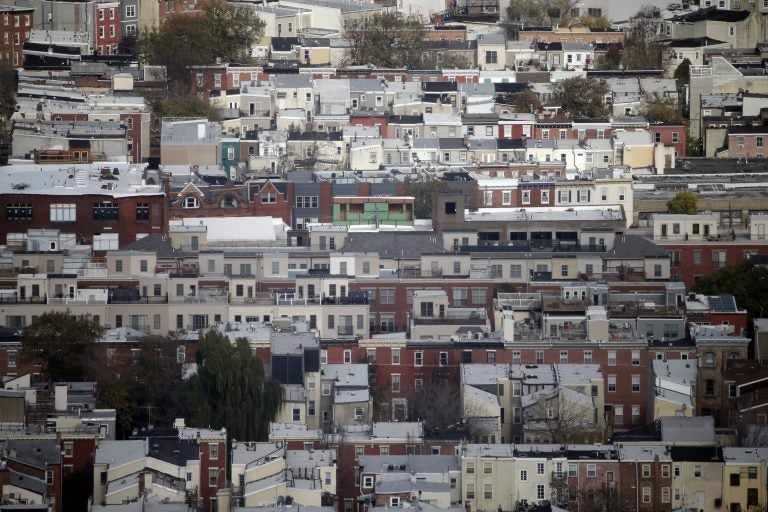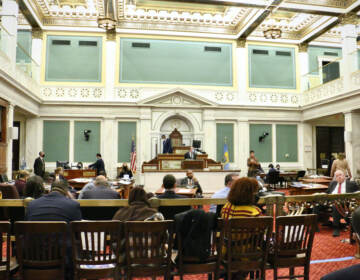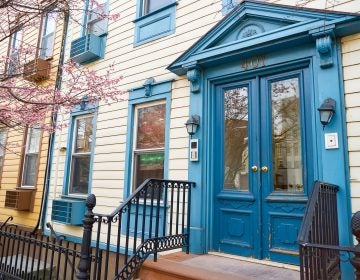Mayor Kenney plans no-strings-attached cash aid program for renters
Mayor Jim Kenney’s office is preparing a no-strings-attached cash aid program alongside a rental voucher program.

File photo: Philadelphia rowhouses. (Matt Rourke/AP Photo)
Updated 10:45 a.m.
Mayor Jim Kenney’s office is preparing a no-strings-attached cash aid program alongside a rental voucher program, with plans to compare which generates better results for residents struggling to get by.
This policy venture is part of an effort to massively expand the municipal rent assistance programs — one of which debuted this January — and rebrand them under the umbrella PHLRentAssist. This batch of policies is earmarked to receive $9.5 million this fiscal year and $47.5 million over the course of Kenney’s five-year plan, but only a portion of that will go to the unconditional cash assistance program for low-income renters.
“Through [PHLRentAssist], we will test innovative and cost-effective practices to housing instability and poverty alleviation, including through a cash transfer pilot program,” said Mayor Kenney in his budget address.
There are an array of programs under the PHLRentAssist banner. The Department of Human Services wants to spend $2.1 million on housing support and other aid for young people aging out of the foster system, while the Office of Homeless Services will spend $1.3 million to double an existing rent subsidy program that currently helps 85 chronically homeless people living in emergency housing.
But the biggest amount will come from the Department of Planning and Development, which hopes to spend more than $6 million on the cash assistance program and the new rental voucher program. (The latter will be distinct from an entirely different $2 million rent subsidy program that debuted in January, and goes to landlords who own buildings funded by the federal Low Income Housing Tax Credit.)
Kenney administration officials underscore that this pilot will not be a “Universal Basic Income,” a policy that guarantees regularly recurring amounts of unconditional cash to recipients regardless of their needs.
The Philadelphia experiment will instead target families earning up to 110% of the federal poverty line — $28,820 for a family of four — and who struggle to make rent. The city will select 1,000 households, chosen in a to-be-determined fashion, then half will receive the unconditional cash transfer and half will get a rental voucher.
The payments on average would be about $425 a month, although the details still need to be worked out. For those receiving no-strings-attached cash, the payment will be placed on a debit card, allowing policymakers to track — but not control — how the money is being spent.
“We know people need to fill their rent gaps and one of their biggest expenses is rent,” said Anne Fadullon, the city’s director of Planning and Development. “But we also think a lot of these families know what they need better than the city does, or better than the public sector may know.”
That contention cuts against the political and intellectual theories that have dominated American welfare policy for decades. Cash assistance programs have proven especially vulnerable to political attack, with the bipartisan welfare reform of 1996 massively reducing the effectiveness of the chief federal cash aid program. State-level general assistance programs, which give small cash sums to the poorest, have been zeroed out of many budgets.
Instead, many public assistance programs only give recipients aid for a particular need. The Supplemental Nutrition Assistance Program helps pay for food. Housing Choice Vouchers pay for rent, the Low Income Home Energy Assistance Program contributes to home heating costs. Conservative politicians often attempt to further restrict these programs by trying to limit, say, what kinds of purchases can be made with food stamps.
But some policymakers have been arguing in favor of giving aid recipients more flexibility. What if a family doesn’t need help with the rent in the beginning of the month, but their kids need new shoes at the end of the month? A Section 8 voucher wouldn’t help with that, but the new cash aid program proposed by the Kenney administration could be used that way.
Most recent research shows that when poor families receive cash subsidies, they tend to spend it on food, utilities, and clothing. Studies have not shown a significant increase in other purchases, such as cigarettes or alcohol.
“If this is proven to be effective, it could also have national implications around how we give rental subsidies to people in poverty,” said Maari Porter, Kenney’s Deputy Chief of Staff for Policy & Strategic Initiatives.
The city is in talks with academic program evaluators who will monitor and study the experiment, but what will be measured is still being determined.
The Kenney administration is projecting to spend $30.2 million on the program over the course of five years, but Porter emphasizes that the funding isn’t guaranteed.
“I don’t want to kind of absolutely commit to this, and we’ll be getting continual advice from our evaluators,” said Porter. “If we see, for any reason, it’s not working then we will pause, make adjustments, and improve it. We have the resources for five years, but if it’s not working, well, we’ll stop.”
City Council President Darrell Clarke said that he expected the United Way of Greater Philadelphia and Southern New Jersey to play a role in the program, both in terms of funding and administration. But the Kenney administration says they are still in talks with the nonprofit about which of the city’s many anti-poverty initiatives they want to be a part of and it is too early to say what the outcome of those conversations will be.
United Way of Philadelphia’s CEO, Bill Golderer, could not be reached for comment.
—
This article has been updated to clarify income guidelines.
WHYY is your source for fact-based, in-depth journalism and information. As a nonprofit organization, we rely on financial support from readers like you. Please give today.







